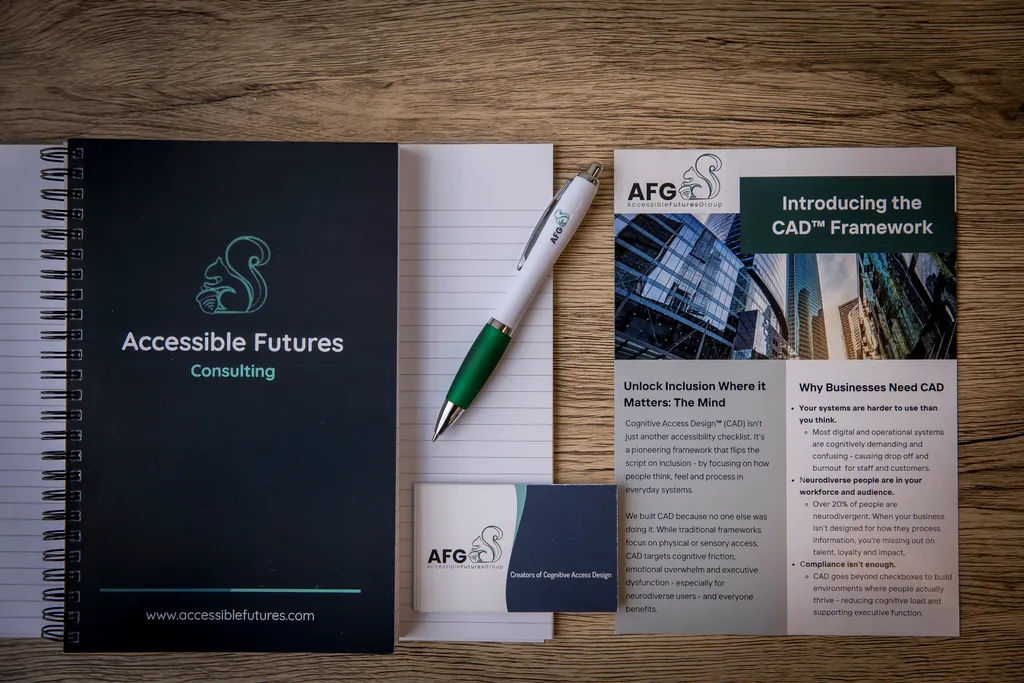Cognitive Access Design™ Framework
The research-backed methodology for cognitive inclusion.

The research-backed methodology for cognitive inclusion.

Cognitive Access Design™ (C.A.D) is the only research-backed methodology specifically designed for cognitive inclusion across digital platforms, physical workspaces, and organizational systems.
Traditional accessibility focuses on physical barriers (ramps, screen readers) and sensory accommodations (color contrast, captions), but C.A.D addresses how neurodiverse minds actually think, process information, and navigate environments.
Developed by our Wales-based team and serving organizations across the UK, this framework transforms how businesses, public sector bodies, nonprofits, and educational institutions approach inclusion.
Unlike one-size-fits-all accessibility solutions, C.A.D is customized for each organization's sector, size, and goals - whether you're a Welsh public body needing Well-being of Future Generations Act compliance, an SME improving workplace inclusion, or a nonprofit reaching neurodiverse communities more effectively.
The Five Pillars of Cognitive Access Design
At the heart of Cognitive Access Design is a flexible design framework built around five core pillars. These pillars help embed access into the structure of environments, not just as an add-on but as part of how things are built from the ground up.
Recognising and challenging structural barriers that exclude or overwhelm users.
Simplifying, clarifying, and pacing content to support focus and comprehension.
Designing environments that scaffold memory, planning, task-switching, and follow-through.
Creating calm, emotionally safe spaces through clear expectations and reduced ambiguity.
Building with, not just for, neurodivergent people through meaningful co-production.

Traditional accessibility leaves 15-20% of the population behind - those with invisible cognitive differences who can physically access systems but struggle to use them effectively.
Cognitive Access Design™ addresses the human experience - transforming how neurodiverse minds actually think, process information, and navigate digital platforms, physical workspaces, and organizational systems across Wales and the UK.
Rather than creating separate "accessible versions" or individual accommodations, C.A.D™ redesigns entire systems to work for diverse minds by default - benefiting everyone while ensuring legal compliance and eliminating administrative burden.
Accessible Futures Group was founded on a social mission. We believe that cognitive access should be a core design principle across sectors, and we want this framework to support as many people as possible.
That’s why the Cognitive Access Design framework and its core principles are open to reference and apply, with appropriate credit to Accessible Futures Group.
We encourage organisations to use Cognitive Access Design as a lens for reflection, design, and service improvement.
Please Note: While the framework itself is open, our training materials and implementation tools are copyrighted and may not be reproduced, adapted, or used for commercial purposes without written permission.
If you’d like to embed Cognitive Access Design within your organisation, training, or services, we invite you to explore our training and consultancy pathways.
If you're unsure whether your use falls within fair use or open licensing please get in touch, we’re happy to help

We’re currently developing a formal C.A.D Certified™ programme to recognise organisations actively embedding Cognitive Access Design in their systems.
Stay tuned for updates—or contact us if you'd like to be part of the early pilot phase.


© 2024 Accessible Futures Group. All rights reserved.